| |
| |
 |
|
| |
P U B L I C A T I O N S > A
R Y S T I L L M A N I
N M E X I C O
Many places served as home for Ary Stillman during
his long and eventful lifetime.
There was the tiny village in White Russia where as a youngster
he fulfilled a vague longing by cutting out designs from rough
paper and filling them in with colors - a collage.
There was the mid-western town in the United States where the
immigrant lad toiled to support himself, his mother, his sister
and brothers, and then by night set up an easel and painted
portraits and still-lifes.
There was Paris in the legendary 20's and 30's where aflame
with the beauty of his surroundings he produced poetic and sensuously
rich canvases acclaimed by Paris critics.
There was New York City where he played a leading role in the
art scene of the 30's, 40's and early 50's, with a steady succession
of one-man exhibitions and group showings.
And then in his last decade there was Cuernavaca.
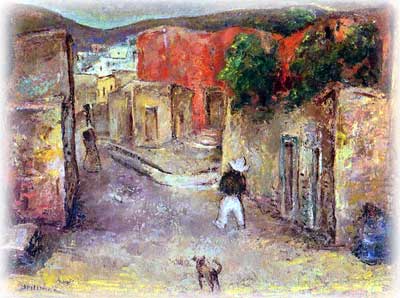 |
Mexican Street Scene
1940
oil on canvas
19 x 25
Foundation Collection |
He had visited
Mexico earlier —back in 1940. Exhausted by the tempo
of the New York art scene, he had hoped to find relaxation
in Mexico. He found not only relaxation but excitement
—peaceful villages and movement-filled city scenes. A
visit of six months resulted in poetic landscapes —Saltillo,
Orizaba, Guanajuato— and crowd-filled Mexico City
scenes —outdoor markets, dance halls, such as Salon
Mexico, which Aaron Copeland made famous to the music
world.
|
 |
Snake Spirits
1960
acrylic on canvas
24 x 18
Foundation Collection |
It was in 1957 that Ary Stillman again repaired to Mexico
following a disastrous year of illness, an eye injury which
threatened to become permanent, the loss of his New York
studio, and a fruitless search for a suitable home in Paris.
It was early in May that Ary and I took a plane for Mexico
City. It was the first time we had flown and I was frightened,
but Ary was fascinated by the view from the window -- cities,
stretches of country and finally cloud masses. I think he
had imagined all this previously, but the actuality was
a delight to him. In Mexico City we went to the Hotel Ontario,
down in the old section not too far from the Zocalo --typically
Mexican of the end of the last century. We discussed where
we should locate ourselves, and had almost decided on San
Miguel de Allende, when Ary met on the street an artist
he knew from New York, Judson Briggs. Judson insisted that
we come to Cuernavaca to look it over at least -- the climate
was perfect, he said -- it was only about 46 miles from
Mexico City and could be reached by bus, and it was ideal
in tempo and surroundings for an artist. So off to Cuernavaca
we went, and it proved to be the setting for us for five
years and for summer vacations for several additional years. |
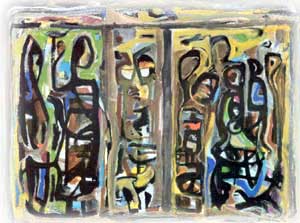 |
Ceremonial
1962
acrylic on canvas
19 1/8 x 25 1/8
The Appleton Museum of Art, FL |
Cuernavaca truly is, as the natives boast, the land of eternal
springtime. Situated in a valley, surrounded by mountains,
including Popocatepetl and Iztaccihuatl, famous from Aztec
times, it is protected from any severe changes of weather.
Soon after we got there the summer rains began, and lasted
through September, but they occur only in the evening and
nighttime, and the days are unbelievably fresh and beautiful.
The fall, winter and early spring are dry, sunny and delightfully
mild, and there are flower-laden trees, bougainvillea vines,
and blossoms of all sorts blooming every month of the year.
Ary loved the little furnished house we rented and was interested
and amused sitting at the outdoor cafes on the square, watching
the colorful and animated scene. But it was long before
he began to paint. He seemed drained of all creative energy;
once in a while he would take up his brushes listlessly
and try to paint, but there was nothing ready to bring forth.
Also, although the scarred eye was improved, there was still
a problem of coordinating the focusing of the two eyes.
I know he worried about his inability to work. But it took
more than a year before he finally laid in a store of canvases
and began ever so slowly to paint. By that time we were
installed on Morelos Street in a duplex house, which had
a lower and upper garden. We had the upper floor and garden
-- stone steps at the back of the lower part of the house
and garden led up to our quarters. There was an enormous
verandah overlooking the lower garden with a view of lemon
trees, bougainvillea vines in brilliant red, purple and
light blue, and beds of flowers, all hemmed in by a high
brick wall, with vista of blue sky and church steeples beyond. |
 |
Group with Little Prince
1963
acrylic on canvas
15 1/2 x 18 1/2
Private Collection |
We had been making occasional visits to Houston where Ary's
sister and her family, the Lacks, lived. In 1963 Ary's deteriorating
health led us to take up permanent residence in Houston,
returning to Cuernavaca in the summertime.
It was in the summer of 1963 that Ary gave up gouaches for
the most part and embarked on a series of exciting canvases,
which he called "Leyendas" (Legends). They had
marvelous movement and each represented a world of fantasy
- a pagan world, but permeated with glimpses of Egyptian,
Byzantine, Coptic, Italian -- every kind of culture, which
had intrigued him during his lifetime. Manny Greer of the
Greer Galleries in New York came down to Mexico that summer
and paid a visit to our place. He was wildly enthusiastic
about the new canvases. He said he had been combing the
studios of Mexican painters and here, in the studio of a
veteran American painter, he found the essence of pre-Columbian
Mexico that the others lacked. But Ary was adamant about
not exhibiting. He had strength only to paint, he said.
To be involved in exhibiting would drain too much of the
precious store of energy. |
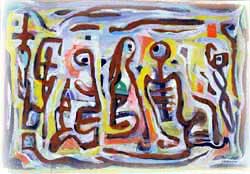 |
Man and Woman
1964
acrylic on canvas
13 1/2 x 20
Foundation Collection, TX |
As Ary said, in Mexico he felt ever more strongly the essence
of the "inner reality," when he "was completely
involved in the mysticism of the subconscious." More
and more of his paintings flowed out of a dream world --
these were not paintings that one brooded over -- they poured
out in a stream from his subconscious.
And with this spontaneous expression came a need for a medium,
which would enable him to work swiftly. Oil paint, no matter
how much he loved it, was slow drying and perhaps one would
have to wait for days before continuing with a canvas that
had been started. So he began to experiment with acrylic
paint. Although it didn't have the rich, sensuous quality
that oil can produce, its quick drying properties made it
possible to get ideas down on canvas or paper before the
dream world could evaporate. So all during our Mexican stay
Ary used the acrylic paint. |
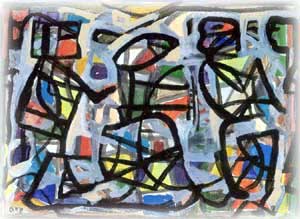 |
Procession
1963
acrylic on canvas
15 1/2 x 22 1/2
Private Collection, CA |
Then the evenings. There was news from the States by radio,
but principally there was our reading. We read everything
on pre-Cortez times that we could find. Prescott's history
of the conquest of Mexico and Peru; Bernal diaz del Castillo,
who described so quaintly and so graphically the country
and the people and the details of the coming of the Spaniards,
as one of Cortez' men; more recent writers on the culture
of the Aztecs, the Mayans, the Incas. Also general mythology
such as the Golden Bough, poetry such as The White Pony,
an anthology of Chinese poetry from 1100 B.C. through 1921.
All this fired Ary's imagination, and what with improved
physical condition, greater peace of mind, and new stimuli
to inspire him, Ary's incredibly rich imagination began
to reassert itself. Now, he fantasized, he had discovered
through excavating among ancient ruins, a "palace of
the prince" and everything that poured forth as he
sat in the arm-chair in the corner of the verandah was something
he carried away from the walls of this ancient palace. So
in 1960 he began a series of gouaches, which in creativeness,
in spontaneity, in line and form are perhaps the culmination,
or at least the beginning of the culmination of his entire
career as a non-representational painter. Ary felt that
himself, "I am a new Ary" he would say. He even
decided that this new Ary should have his name on the paintings
rather than the old Stillman whose depression he had fought
off. So one will find that practically all of the gouaches
and many of the later canvases bear the name Ary. Later
on, after we left Mexico, he drifted back into signing Stillman
again. |
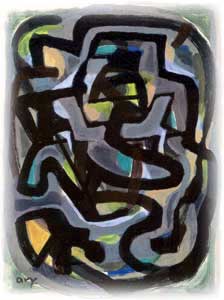 |
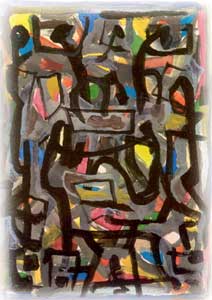 |
From the Temple of the Young Prince
1961
gouache on paper
21 x 22
The Columbus Museum of Art, GA
|
Ritual
1965
gouache on paper
26 x 20
Montclair Art Museum, NJ |
|
Gradually,
slowly, Ary began to introduce color into the canvases.
They were becoming more decisive also. That they had impact
was quite clear to us when Bart, a Duth painter, came over
one day and as Ary brought out one canvas after another
all Bart could say was; "Jesus, Ary! Jesus!"
Life was beginning to be happy for Ary. Mornings were spent
working in the garden, marketing with or without me at the
street stands, which lined the way to the big market, sitting
at one of the outdoor cafes on the square, sipping a cappuccino.
Then dinner out on the verandah -- at this altitude everyone
has his main meal in the middle of the day. Then a nap,
and about three o'clock, refreshed by sleep and a cup of
tea, Ary would settle himself in the armchair in the corner
of the verandah, sit there dreaming for some time and then
taking up his brushes, begin to transfer his dreams to canvas.
About six o'clock he would put his work away and we would
go down to one of the cafes again, to meet with friends
or just to sit there taking in the lively scene, listening
to the Mariachi bands. Later during our stay, after we had
studied Spanish for some time by ourselves, we enrolled
as "oyentes" at the little university a couple
of blocks away, and attended six and seven o'clock classes
there, listening to lectures on literature, psychology --
whatever was offered -- just to get the diction and the
feeling of the language. The youngsters probably thought
we were quite crazy, but they were very respectful and courteous
to us anyway.
|
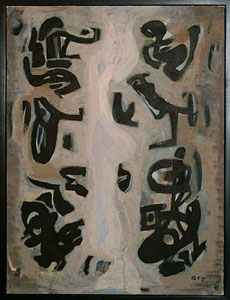 |
Scherzo (Calligraphic)
1960
acrylic on canvas
Green Room
University of Houston,
Moores School of Music, TX |
Ary loved the garden -- he was up early in the morning and
out there in his bathrobe and straw-brimmed hat, raking
the leaves and putting the place to rights, even before
he had his breakfast. He fixed a corner for himself on the
verandah, where there was a big armchair. There he set up
the small easel he had bought in Paris and there the flow
of creativeness gradually came back to him. At first he
avoided colors -- the distorted vision of the right eye
still bothered him, but he felt that he could handle black
and white. One of Ary's great delights was to go to the
old cathedral not far from our house, and to walk inside
the walls, seeing every time new images and fantastic blends
of textures -- a marvelous patina that had evolved through
the years from wind and sun and particles of earth. One
of Ary's black and white canvases from that period which
he named "Design on an Old Wall" showed strong
black curving lines making sort of a flowing figure, against
a background which gives the feeling of the texture of these
walls.
|
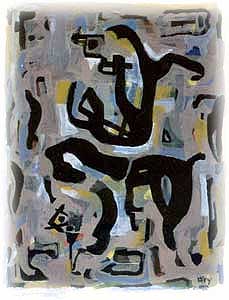 |
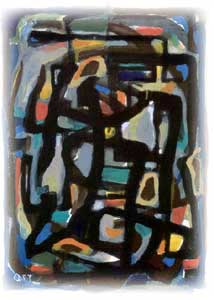 |
Caprice
1961
gouache on paper
Green Room
University of Houston,
Moores School of Music, TX
|
Stained Glass #2
1961
gouache on paper
Heckscher Museum of Art, NY |
|
The
excitement and high pitch of creative energy carried over
intermittently for the remainder of his life. In his final
months he would be lost in melancholy for hours at a time
but when he roused himself enough to paint, the old spirit
would reassert itself and some powerful and striking canvases
were forthcoming.
To sum up Ary's Cuernavaca experience I should like to quote
from Richard Teller Hirsch's introduction to the 1972 Stillman
Retrospective at the Houston Museum of Fine Arts:
"…living in Mexico he pondered Mayan riddles.
He worked to say powerful things evoked from strange dimensions
of time. The Mayas and the Incas haunted him, his brush
moved boldly in answer to echoes within his mind as his
intuition evoked them…It was a free communion in strong,
effervescing terms with something felt, the feeling of another
timeless cosmos. Such from the depths of despair, were the
flowerings, which Ary Stillman brought forth. He had once
been a painter who saw with feeling. In the last years of
rebirth, feeling had made him surpass response to mere visual
perception. Growing in strength, although his body grew
weaker, commanding obedience from his tools to state fervently
and decisively the inner dictates of his intuitive echoings
Ary Stillman, the visionary, triumphed, his work achieved,
destiny fulfilled …"
|
|
|
|











